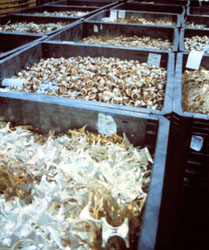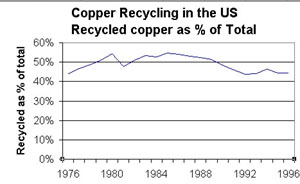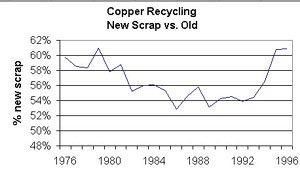Overview of Recycled Copper
Copper Applications in Health & Environment
Copper and copper alloys have been recycled for hundreds of years. Early on, man learned that if newly mined copper ore was not available, copper objects could be melted and cast into new objects. During wartime, weapons were made from recycled decorative and household goods, and even bells. After the war they were turned back into non-war related products. Prior to the American Revolutionary war, all American made copper and copper alloy products were made with recycled metal because the British mandated that all copper ore be sent to England for processing. Since those early days recycled copper has remained a major source of copper in the United States, accounting for almost half of the copper produced and sold each year.
The Scrap Flow
 Copper Scrap
Copper ScrapToday, the process of transforming unalloyed copper scrap into new copper products begins with purchasing copper scrap from a national network of scrap processors and brokers. No. 1 scrap consists of clean, unalloyed, and uncoated copper solids,clippings, punchings, bus bars, commutator segments, clean pipe and tubing. No.2 copper scrap is the same but may include oxidized or coated/plated pieces including oxidized or coated copper wire free of excessive oxidation.
When copper scrap is received for recycling it is visually inspected and graded, and analyzed chemically if necessary. Loose scrap is baled and stored until needed. No. 1 scrap material is directly melted and in some cases brought to higher purity while molten (fire refined). Chemical analysis checks the purity level of the copper when the charge is fully melted, and the molten copper is deoxidized and cast into an intermediate shape (billets, cakes, ingots) for further processing. Number 2 scrap is usually electrolytically refined to attain the desired purity level. But first the scrap material is perhaps fire refined somewhat, melted and cast into anodes. These anodes are the raw material used in cathode production. The anodes are then electrolytically refined, essentially an electroplating process in which the anode is electrolytically dissolved into a bath of sulfuric acid and then electroplated out of the solution onto a stainless steel sheet. Thin sheets of pure copper are pulled off the stainless sheet and placed between anode plates in other electrolytic cells where further electroplating transforms these anodes into 99.98% pure copper which builds up into cathodes as it plates out on the thin pure copper starter sheets.
Copper alloys are also recycled. Alloy scrap has to be segregated, kept clean and identified so that the alloying elements and impurity content of each batch are known. Scrap of unknown composition may be melted and analyzed to determine its composition. Alloy recycling is then accomplished by melting together batches of scrap of known composition, perhaps along with virgin material, carefully compounded so that the recycled material has the alloy composition desired.
Statistics
Most copper and copper alloy scrap - in the US 64.5% in 1996, is remelted directly by brass mills, wire rod producers, foundries and ingot producers. The remainder 599 tons (35.4%) in 1996 goes back into the supply stream at the smelting and refining stages. Of the 1,092,600 tons of scrap that was directly remelted in the US 1996, about 22% was recycled into ingot cast copper alloy products by producers and foundries, 70% was recycled by brass mills and about 8% was reused by other industries, powder-producers, and by wire rod mills. Consumption of copper scrap for alloys has grown by over 50% in 20 years. Increased consumption by brass mills accounts for virtually all of the additional scrap consumed. Scrap going for cast products has remained essentially the same; copper alloy cast products have not kept pace with the growth rate pace set by the brass mills.
Copper and copper alloy scrap is a very significant factor in making the United States self sufficient in its overall consumption of copper. In 1996, U.S. mine production was 2,104.8 thousand short tons; along with that new-mined copper 1,691.7 thousand short tons of copper in domestic scrap entered the supply stream giving a total copper consumption of 3,796.5 thousand short tons.
Scrap thus provided 44.6% of the total copper consumed. As shown below, scrap consumption over the past 20 years has provided between 44 and 54.7% of the total copper consumed in the US each year. The intrinsic value of copper scrap, along with the simple technology of copper recycling, drives this process. No. 1 copper scrap commands well over 90% of the price of new refined copper.

The largest category of scrap is customer returned "new" scrap which is directly remelted. The extent of recycling of "old" or obsolete scrap tends to fluctuate depending on copper prices and other commercial considerations. Recovery rates of old scrap decline when copper prices are low. Old scrap, also called post consumer scrap, consists of discarded electric cable, junked automobile radiators and air conditioners and innumerable other products. This is low-velocity material with product life of 10 to 100 years or more. The trend had been toward more old scrap and less new in the recycling stream. New scrap has decreased from 61% to about 54% of the total U.S. scrap recycled in 1992, but has bounced back up to 61% in 1995 and 1996. The graph below shows these trends.

Users of Scrap
The only significant drawback to using recycled copper is that it may contain trace impurities that negatively impact its properties. As a result, some applications require newly mined, or primary copper or scrap copper that has been re-refined or re-smelted and re-refined. The most important of these applications is high conductivity wire.
Ingot producers and large captive foundries have traditionally been large consumers of used copper/brass automotive radiators. This material conveniently provides copper, zinc, tin and lead units in relative amounts that are ideal for production of the approximately 100,000 short tons of red-brass and semi-red brass alloy ingots. About half of this ingot material is used for plumbing valves and fittings in the U.S., a distinctly different picture than in Europe where yellow brass (copper-zinc alloys) predominates in plumbing products.
The radiator to red brass transformation has been an economically driven and environmentally sound recycling of valuable materials. No detailed statistics on the contribution that radiator scrap makes to the 250,000 tons of scrap consumed for cast products exist, but discussion with ingot manufacturers indicates that over recent years radiators have accounted for about 50% of the US production of red and semi-red brass alloys. About 50,000 tons of radiators per year are recycled by ingot producers. The plumbing alloys themselves, as both post consumer product and prompt scrap returns, have also been a significant contribution to the ingot producers' incoming material.
Conclusion
It is estimated that throughout history about 700 billion pounds of copper have been mined to date, with the majority of it is still in use today. The copper and copper alloy industries rely on the fact that scrap copper is easily and economically used and reused.
Also in this Issue:
- Trapping Sulphur
- Green Roofs for a Greener Environment
- Overview of Recycled Copper
